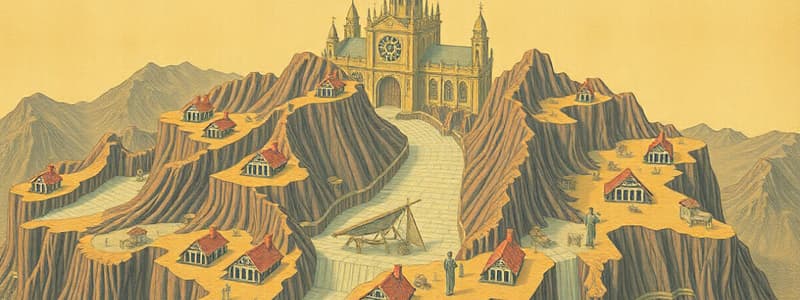Podcast
Questions and Answers
What is an ellipsis used to indicate?
What is an ellipsis used to indicate?
- A complete thought
- An exclamation
- A new idea
- An omission or a pause (correct)
What does the term 'esoteric' refer to?
What does the term 'esoteric' refer to?
- General interest information
- Specialized knowledge understood by a limited audience (correct)
- Common knowledge
- Basic concepts applicable to everyone
What is the primary definition of 'to mitigate'?
What is the primary definition of 'to mitigate'?
- To reduce or ease (correct)
- To strengthen
- To eliminate completely
- To complicate matters
Which of the following describes 'comprised of'?
Which of the following describes 'comprised of'?
What does 'slope failure' refer to?
What does 'slope failure' refer to?
What is a key characteristic of a fault in geology?
What is a key characteristic of a fault in geology?
How is a landslide primarily caused?
How is a landslide primarily caused?
What is orogenesis?
What is orogenesis?
What is the highest intensity category on the European Macroseismic Scale?
What is the highest intensity category on the European Macroseismic Scale?
Which of the following best describes the magnitude of an earthquake?
Which of the following best describes the magnitude of an earthquake?
What term is used to describe the sudden violent movement of the Earth's surface?
What term is used to describe the sudden violent movement of the Earth's surface?
Which intensity category indicates the least amount of seismic activity?
Which intensity category indicates the least amount of seismic activity?
What do geologists use to measure the strength of an earthquake?
What do geologists use to measure the strength of an earthquake?
Which of the following categories may indicate an increase in damage when assessed?
Which of the following categories may indicate an increase in damage when assessed?
How many degrees of intensity are listed in the modified intensity scale?
How many degrees of intensity are listed in the modified intensity scale?
Which term refers to the plates causing earthquakes through their movements?
Which term refers to the plates causing earthquakes through their movements?
What term describes the result of the Earth's crust movement along fault lines?
What term describes the result of the Earth's crust movement along fault lines?
Which component of the Earth is involved in the formation of earthquakes?
Which component of the Earth is involved in the formation of earthquakes?
What is the primary force that causes damage during an earthquake?
What is the primary force that causes damage during an earthquake?
Which geological feature is essential for understanding the cause of earthquakes?
Which geological feature is essential for understanding the cause of earthquakes?
What is referred to when the Earth's crust moves and causes the surface to shake?
What is referred to when the Earth's crust moves and causes the surface to shake?
What geological process describes a body of rock formed from magma that cools within the crust?
What geological process describes a body of rock formed from magma that cools within the crust?
What causes an earthquake according to the principles of plate tectonics?
What causes an earthquake according to the principles of plate tectonics?
What term describes a shallow body of water separated from a larger body by landforms?
What term describes a shallow body of water separated from a larger body by landforms?
Which term is described as a crack in the Earth's crust with no movement?
Which term is described as a crack in the Earth's crust with no movement?
What type of rock undergoes transformation by heat and pressure?
What type of rock undergoes transformation by heat and pressure?
Which of the following is NOT one of the basic types of plate movements?
Which of the following is NOT one of the basic types of plate movements?
Which type of fault involves horizontal movement along the plane?
Which type of fault involves horizontal movement along the plane?
What do all types of plate boundaries potentially lead to?
What do all types of plate boundaries potentially lead to?
What is the term used to describe the extreme damage that requires replacement rather than repair?
What is the term used to describe the extreme damage that requires replacement rather than repair?
How is the intensity of an earthquake typically measured?
How is the intensity of an earthquake typically measured?
Which process is NOT a direct result of tectonic plate interactions?
Which process is NOT a direct result of tectonic plate interactions?
What primarily triggers a landslide?
What primarily triggers a landslide?
Which of the following materials are commonly involved in a landslide?
Which of the following materials are commonly involved in a landslide?
What is the primary focus of geotechnology?
What is the primary focus of geotechnology?
Which layer of the Earth is solid and located between 5,100 km and 6,400 km deep?
Which layer of the Earth is solid and located between 5,100 km and 6,400 km deep?
What does the term 'rift' refer to in geology?
What does the term 'rift' refer to in geology?
Which of the following actions may lead to ground saturation and potentially trigger landslides?
Which of the following actions may lead to ground saturation and potentially trigger landslides?
What is the general significance of geosciences in relation to everyday life?
What is the general significance of geosciences in relation to everyday life?
What effect does gravity have on saturated soil in elevated areas?
What effect does gravity have on saturated soil in elevated areas?
Flashcards
Landslide
Landslide
The downward movement of soil, rock, and other debris due to gravity, often triggered by rainfall or seismic activity.
Geotechnology
Geotechnology
The science and engineering of soil, rock, and the fluids within them.
Lithosphere
Lithosphere
The solid, outermost part of the Earth, including the crust and upper mantle.
Fault
Fault
Signup and view all the flashcards
Rift
Rift
Signup and view all the flashcards
Ellipsis
Ellipsis
Signup and view all the flashcards
Dip-slip Fault
Dip-slip Fault
Signup and view all the flashcards
Esoteric
Esoteric
Signup and view all the flashcards
Strike-slip Fault
Strike-slip Fault
Signup and view all the flashcards
Mitigate
Mitigate
Signup and view all the flashcards
Comprised of
Comprised of
Signup and view all the flashcards
Earthquake
Earthquake
Signup and view all the flashcards
Slope failure
Slope failure
Signup and view all the flashcards
Plate Tectonics
Plate Tectonics
Signup and view all the flashcards
Focus
Focus
Signup and view all the flashcards
Epicenter
Epicenter
Signup and view all the flashcards
Quarry
Quarry
Signup and view all the flashcards
Intensity Scale
Intensity Scale
Signup and view all the flashcards
Quarry (verb)
Quarry (verb)
Signup and view all the flashcards
Fault Line
Fault Line
Signup and view all the flashcards
Mantle
Mantle
Signup and view all the flashcards
Intrusive Igneous Rock
Intrusive Igneous Rock
Signup and view all the flashcards
Extrusive Igneous Rock
Extrusive Igneous Rock
Signup and view all the flashcards
Metamorphic Rock
Metamorphic Rock
Signup and view all the flashcards
Lagoon
Lagoon
Signup and view all the flashcards
Coral Reef
Coral Reef
Signup and view all the flashcards
Earthquake Intensity Scale
Earthquake Intensity Scale
Signup and view all the flashcards
Earthquake Magnitude
Earthquake Magnitude
Signup and view all the flashcards
Tectonic Plates
Tectonic Plates
Signup and view all the flashcards
Earthquake Strength
Earthquake Strength
Signup and view all the flashcards
Seismic Waves
Seismic Waves
Signup and view all the flashcards
Seismographs
Seismographs
Signup and view all the flashcards
Study Notes
Technical English Week 1.2
- Course agenda includes: attendance review, vocabulary and video for geotechnology reading, breaks, faulting, plate tectonics, earthquakes, rock cycle vocabulary reading, readings and exercises, and a video on orogenesis.
- Module policies cover point allocation for active participation and attendance requirements for the final exam.
- A glossary of terms includes ellipsis (punctuation), esoteric (understood by few), mitigation (reduce harm), comprised (composed), slope failure (soil movement), landslide (mass movement), and definitions for specific rock types.
- Slope failure causing landslides is illustrated with a diagram and described as saturated soil moving downhill due to gravity. A video from NASA illustrates how rainfall can trigger ground saturation.
- The course also covers Earth's layers (crust, mantle, liquid core, solid core) and plate tectonics.
- Plate tectonics involves three main types of plate boundaries: divergent (plates separating), convergent (plates colliding), and transform-fault (plates sliding past each other).
- Faulting involves cracks in the Earth's crust along which movement occurs. Two common fault types are dip-slip and strike-slip faults.
- Earthquakes are measured by intensity (ground shaking) and magnitude (seismic energy). An intensity scale helps measure damage.
- Magnitude, a logarithmic scale, measures the size of an earthquake. It is calculated from waves of the earthquake and data from instruments (like in Edinburgh).
- Types of rocks (sedimentary, igneous, metamorphic) are defined and examples are given. Vocabulary includes, prefixes, intrusion, and extrusion.
Studying That Suits You
Use AI to generate personalized quizzes and flashcards to suit your learning preferences.


